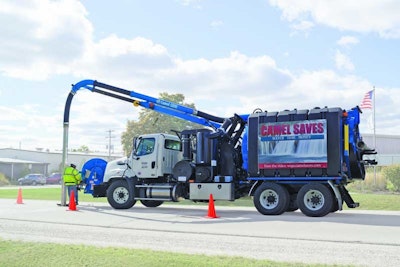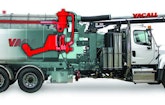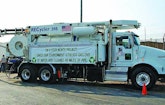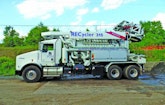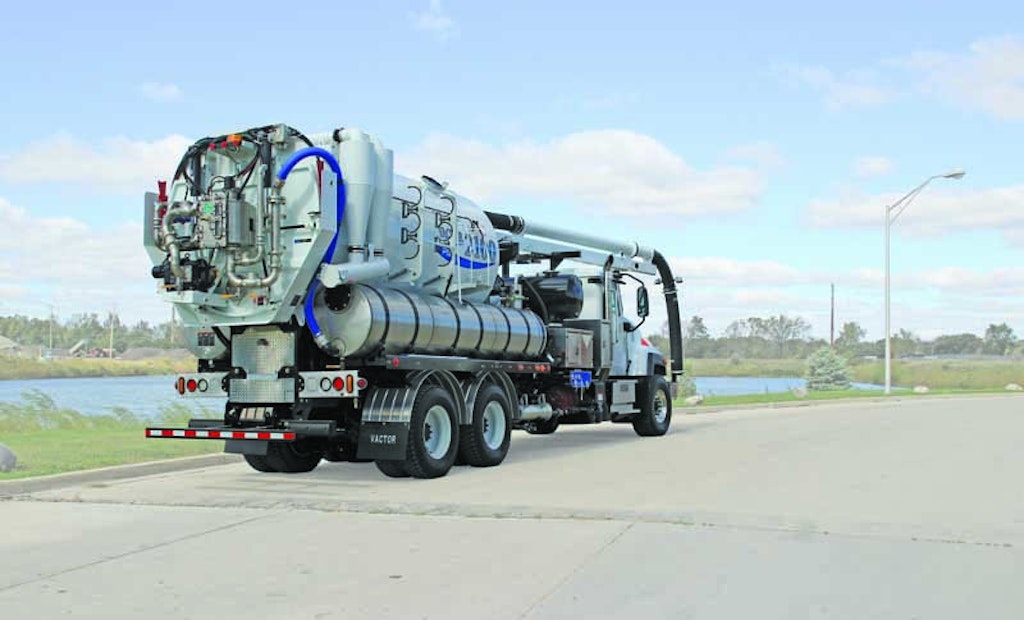Interested in Trucks?
Get Trucks articles, news and videos right in your inbox! Sign up now.
Trucks + Get AlertsA small group of early-adopter contractors is using new water-recycling vacuum trucks to clean sewer lines. If adopted on a large scale, the technology could potentially save municipalities voluminous amounts of water a year — an especially attractive benefit for drought-stricken regions — as well as reduce sewer cleaning costs.
Manufactured by J. Hvidtved Larsen A/S in Denmark, the RECycler water-reclamation vacuum trucks are currently being used in California, Ohio and along the East Coast. Already popular in Europe, the RECyclers operate like normal vacuum trucks, with one glaring exception: They don’t need to fill up with potable water in order to work. Instead, the truck removes water from debris it sucks from sewer lines, then cleans it and reuses it for waterjetting.
“The municipal officials who have seen how this truck performs have a high appreciation for its benefits,” says Jim Lounsbery, executive vice president of National Water Main Cleaning Co., based in Kearny, New Jersey. The company runs about 70 conventional vac trucks along the East Coast, mainly for municipal sewer cleaning, and owns two RECycler 315s, one based in Kearny and one in California. “The RECycler is almost like a portable water treatment plant.”
It’s difficult to quantify exactly how much water the RECyclers save per job. But John Sullivan, the sales and customer support manager for J. Hvidtved Larsen’s operations in the U.S., estimates that the unit can save about 20,000 gallons of water per day compared to a conventional vacuum truck. Lounsbery points out that a traditional vac truck with an 80 gpm water pump that runs for six hours a day could use nearly 30,000 gallons of water.
But no matter how one extrapolates the numbers, the water savings could be substantial if the technology is adopted nationwide. “From a conservation perspective … think about the people in California who eat off paper plates because they don’t want to use water to wash dishes,” Lounsbery says. “I think the ability to reuse sewer water to clean pipes and not tap into that valuable freshwater resource represents the future of the industry.”
Water-recycling vac trucks could also reduce operating costs for municipalities because sewer cleaning contractors won’t be taking potable water from fire hydrants, using it to clean pipelines, then putting it back into the system to get treated again. “You’re saving taxpayers the cost of reprocessing clean water,” Lounsbery points out.
“There’s a cost savings there for municipalities,” says Brandon Long, a civil engineer for Burgess & Niple, an engineering and architectural company that works with water and wastewater utilities. Long has seen the RECycler technology in action twice during the last year and came away impressed. “When contractors pull treated water (from a hydrant), there are costs associated with treating that water before it’s used,” he says. “And if you treat water to make it safe to drink, it’s a wasted expense if you don’t use it for that purpose. Then you pay to treat it again (after it’s used for jetting).
“But when you pull water from a sewer, the water has at least already been used,” he adds. “So the benefit is similar to any other form of recycling — you’re getting a second use out of it.”
Another potential benefit: Contractors will be able to clean more linear feet of sewer per day, and that enhanced productivity could reduce sewer cleaning expenses for municipalities.
Where does that efficiency come from? Instead of wasting time going back and forth to fire hydrants to refill vac trucks’ water tanks, contractors can spend all day on a job site, never leaving to refill a water tank. Keep in mind that most vac truck pumps generate flow of 80 to 120 gpm. So with an 1,800-gallon tank, a truck can run out of water in about 15 minutes.
“You’re lucky if you can clean 250 feet of line in that 15 minutes,” Lounsbery says.
National Water Main workers find access to hydrants is becoming more and more limited, which means operators must run back and forth to public works departments to fill up, Lounsbery says. “It could be a 5- or 10-mile trip from a job site, depending on the size of the community,” he says. As such, operators might lose two to three hours a day running for water instead of performing productive work, he notes.
“We’ve seen productivity of up to 3,000 feet (of pipe cleaned) per shift with the RECycler versus 2,000 feet per shift with a two-man crew and a traditional vac truck that needs to make runs for more water,” he says. “The productivity increase is truly significant.”
Lounsbery notes that the RECycler enables contractors to use manpower more efficiently, which also reduces costs. For example, a RECycler requires just one operator, while a traditional vac truck might require an operator, plus another worker to drive a water truck to a job site if the designated hydrant is so far away that refills become costly and inefficient.
“All those inefficiencies drive up costs for municipalities and eventually taxpayers in those communities pay for those costs,” he explains. “The bottom line is I can bid on jobs cheaper because of the RECycler, so municipalities save money.”
Ohio-based C&K Industrial Services Inc., which offers industrial and municipal cleaning services, bought a RECycler 315 about a year ago after seeing one at a Water & Wastewater Equipment, Treatment & Transport Show, says Henry Sorensen, the company’s fleet manager. The unit features a 2014 Kenworth T-800 truck chassis; a water pump made by URACA (124 gpm at 2,175 psi); a vacuum pump made by CVS Engineering (1,825 cfm at 25 inches Hg); a hydraulic, swiveling hose reel that carries 660 feet of 1 1/4-inch-diameter hose; and a second reel for smaller-diameter hoses.
Two features set the machine apart from conventional vacuum trucks. The first is the water-recycling system. Here’s a simplified explanation of how it works: The truck vacuums up water-filled sludge into the debris tank. The reclamation system sucks that water out of the debris, then sends it through a set of filters and cyclones that separate heavy solid particles.
From there, the solids go into the sludge tank and water is pushed into the water tank, where it travels through another set of even finer filters. Then it’s ready to be used for waterjetting operations, Sorensen says.
“It takes about 15 minutes to clean enough water to start jetting,” Sorensen says.
“But we have to be cleaning a sewer with running water in it. If it’s a dry sewer, we have to bring water along. But if it has decent flow, there’s no problem starting a job without any water in the tank.” When a cleaning operation concludes, any water still in the tank gets put back into the sewer system.
The truck offers another unique feature: a pneumatically operated partition that allows the operator to make the water tank bigger and the debris tank smaller, or vice versa, as needed.
At the start of a cleaning operation, the partition is positioned as far back as possible to allow for more water and less debris capacity. But the partition gets moved forward as work progresses, so the debris section gets bigger and the water section gets smaller. When crews complete a typical line cleaning, two-thirds of the tank is devoted to debris and the remaining third to water, he explains.
Moreover, in a typical cleaning, 90 percent of the debris is so dry that it’s ready to be hauled straight to a landfill, with no need for time-consuming decanting, Sorensen says.
“Eliminating that step makes us more cost-effective,” he notes.
Water-recycling vac truck technology is just starting to gain traction in the United States. But manufacturers and operators are both climbing on board. “It’s in its infancy right now,” Lounsbery says. “There just aren’t enough units out in the field to drive the point home about the benefits to municipalities.
“We were skeptical at first,” he adds. “But we’ve been pretty impressed with Larsen’s responsiveness and the unit’s performance in the field. Eventually the word about the benefits will get out.”
More manufacturers roll out recycling technology
The RECycler from J. Hvidtved Larsen A/S has been proven in Europe, and now that it’s gaining a foothold in the U.S. as demand for water recycling technology grows, other manufacturers are following suit with their own systems.
Super Products, Vacall and Vactor are among the manufacturers who are addressing this emerging segment of the market with systems aimed at saving water, time and money.
The Camel 1200 jet/vac trucks with water-recycling packages use substantially less potable water to clean sewer lines. In fact, the unit will save an average of about 8,000 gallons of water a day while cleaning 1,000 feet of sewer (though that number could vary a bit, depending on the pipe’s diameter), says Mike Drott, Midwest regional sales manager for Super Products.
“That also means that stormwater treatment plants are treating 8,000 fewer gallons per day,” he notes.
Moreover, field tests show that the water-recycling Camels improve productivity by about 40 percent because they can operate continuously, with no need to make time-consuming — and sometimes expensive — trips to refill the water tank. In fact, if there’s sufficient water flowing through the sewer line being cleaned, the unit can actually work with an empty water tank. If there’s no water in the sewer line being cleaned, one full tank of water will provide enough to work all day without refilling, Drott explains.
Here’s a simplified explanation of how it works: In a primary settling chamber in the debris tank, a device called an ejector plate separates the liquids and solids. Then the water passes through the plate, which serves as the primary filtration point, and enters a sediment chamber. From there, the water is first pumped through a filtration screen and then through a centrifugal separator and a Y-strainer. Then it’s fed into the jetting water pump, ready to be used for further cleaning.
“It’s pretty much a closed-loop system from the sewer to the debris tank, then through the water pump and back into the sewer,” Drott says.
At the end of a workday, the hydraulically operated ejector plate can be sent to the rear of the debris tank to compact the solids. Any remaining water is pumped out, leaving the truck with a dry load, Drott says.
The AllClean water-recycling option for Vacall AllJetVac combo units is designed to meet the same objectives.
The system uses a series of filters, screens and centrifugal motions to remove matter from water collected in the debris tank before returning it to the water tanks.
A multistage recycling process starts with an initial sediment separation followed by a floating V-Filtration screening process further separating water from debris. The V-Filtration also has backflush, self-cleaning capability. Centrifugal action removes remaining solids, including particles down to 100 microns. Solids and fine particles are returned to the debris tank via a pressure-regulating valve system. Recouped jetted water — up to 65 percent from a sewer line — is returned to the water tanks for reuse.
“Productivity is going to increase tremendously,” says Bill Petrole, vice president of sales and marketing for Vacall. “If you have a large job with a lot of jetting to do, it doesn’t take long to empty your water tanks. The benefit would be the length of time you can stay on the job or stay away from the dump.”
The system is located at the front of the AllJetVac debris body, protected from damage by stones or other vehicles. Petrole says this also allows them to offer an inexpensive alternative to a dedicated truck.
“We can take a normal sewer truck that we’re producing and, as an option, add the recycler onto it so the municipality has a dual-purpose machine,” he says. “They can fill up the water tanks in the morning and go out and use it like a conventional combo truck, or they can go out in the morning and recycle water and use it as a recycler.”
“The recycling concept has been in Europe for a long time, and the system that we’re using has been around for a long time,” Petrole says. “It’s a proven way of doing things.”
Vactor developed its first water-recycling system in the 1980s, but its most recent version is much more user-friendly, says Dave Brockman, a product manager at Vactor.
“It was a bit ahead of its time, but that system required getting into the debris body to maintain it, and what we found is you’re going to do that one time and you’re never going to want to do it again,” he says. “That’s why we went back to the drawing board and developed the system we have now.”
That’s one of the top features of Vactor’s newest water-recycling system — no moving parts inside the debris body. Everything is located on the exterior of the machine, making it easier and safer for operators to maintain.
“One of our main design criteria was to make sure nobody ever had to get inside that debris tank to maintain the system,” Brockman says.
The system, an option for Vactor’s 2100 Plus Series, uses a five-stage filtration process: natural settling in the debris body followed by a coarse-screen filter, centrifugal separation, a classification filter rated at 100 microns, and final settling in a stainless steel reservoir.
“Productivity can increase up to 100 percent while saving thousands of gallons of freshwater every shift,” Brockman says.
Vactor did a demo recently for one contractor, who was able to save 21,660 gallons of freshwater during a single day of work.
“Taking care of the environment and ensuring clean water resources is at the core of what Vactor and the 2100 Plus Series are all about, so adding water-recycling technology was a natural step in our long history of product innovation,” Brockman says.
